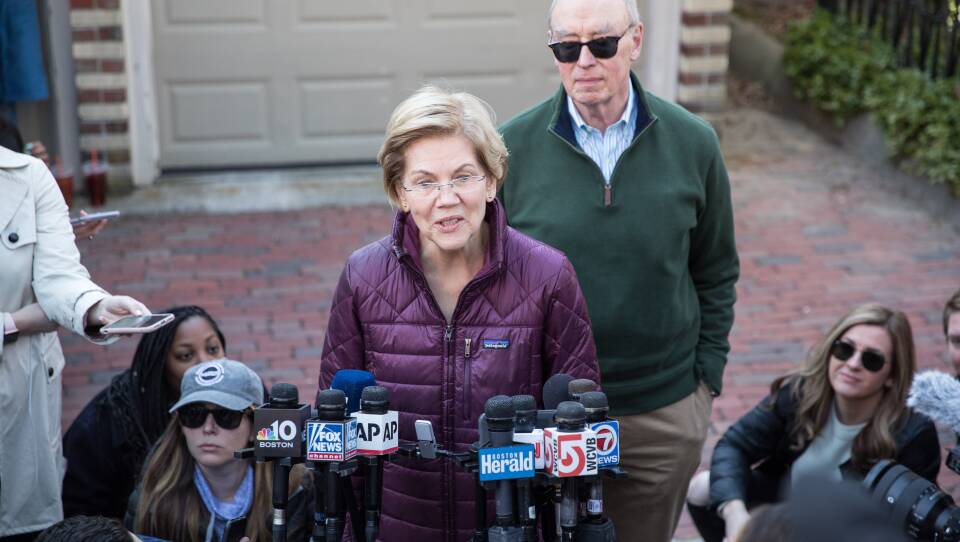I canvassed in New Hampshire for Elizabeth Warren most weekends from July 2019 through February 2020. Week after week the voters of Rockingham County told me that Elizabeth Warren was the smartest candidate in the race. They liked her. They trusted her. But they just didn’t believe that other voters would elect a woman president, which made them reluctant to back her. I’m convinced that if Warren were a man and had executed the exact same campaign, the male version of Warren would now be the presumptive Democratic nominee for president.
Campaign post-mortems that fail to grapple with sexism as a significant component of Warren’s demise teach us nothing. How can Warren’s health care plan be touted as a disastrous turning point in her campaign without also mentioning that the press routinely grilled Warren on the details of her plan while letting Bernie Sanders get away with speaking of Medicare for All in lofty generalities?
From the beginning of Warren’s campaign, media bias against female candidates was Warren’s most formidable obstacle. Just hours after she announced her candidacy, Politico posted a piece questioning Warren’s likeability and electability. The story was so egregious that it kicked off a massive debate about sexism in media coverage. Plenty of pundits lined up to absolve the media of bias by claiming that Warren was, indeed, unlikeable. Media critic Dan Kennedy was more nuanced than most in his defense of the press, allowing for the fact that there was some sexism at play in how the media covered Warren’s announcement. But he urged people to “not get carried away — it’s not just sexism. Republicans used the likability factor like a sledgehammer against Al Gore and John Kerry, and it was effective.”
In a patriarchy, women are held to higher and more exacting standards than men in school, the workplace, and at home. But misogyny affects people of all genders. Men who are not sufficiently masculine get punished, and people who are transgender or nonbinary get erased. A 1999 column by Maureen Dowd contrasting the “robotic, plodding” Gore with the “popular” Bush illustrates this perfectly.
“Al Gore is so feminized and diversified and ecologically correct, he’s practically lactating,” Dowd wrote. “George Bush is all swagger, with macho campaign accessories of custom-made ostrich-leather black cowboy boots with ‘G.W.B.’ emblazoned and a huge belt buckle with ‘Gov. George W. Bush,’ as well as baseball statistics, pork and beans and a Betty Crocker wife.”
In the early days of the 2020 Democratic primary campaign, the New York Times published two deeply reported pieces examining whether a woman could defeat Donald Trump and the role sexism plays on the campaign trail. Incredibly, neither piece examined the ways in which female candidates are harmed by gendered political coverage and commentary.
On Twitter, where Times political editor Patrick Healy has been providing behind-the-scenes context to some of these big political stories, he inadvertently revealed his own lack of understanding of the ways systemic sexism infects coverage. “Are we too focused on gender? I don't think so,” he tweeted. “Sexism and double standards are very real in politics -- many women face harsh judgments about ambition, looks, personality, likability, while many men do not. (Though some men do; likability was an issue for @tedcruz with voters.)”
The tweet was met with a spate of withering replies pointing out that Ted Cruz is widely viewed by his GOP colleagues as rude, grandstanding and unreliable while the same could not be said of the female Democratic candidates for president.
Ultimately, Warren’s campaign ended when she just didn’t get the votes. After the January 15 debate during which Bernie Sanders denied ever having said to Warren that a woman could not win against Trump, it seemed more likely than not to me (though I didn’t want to be believe it) that voters were not going to back Warren. The weekend after that debate, one voter after another expressed their disgust to me with Warren’s behavior on stage. One woman told me that Warren had been unnecessarily mean to Sanders.
So where does this leave us, other than a state of complete despondency about the prospect of ever electing a woman president? Well, we’re further ahead of where we were four years ago in three significant ways. The first is that while some of the Warren campaign post-mortems either dismiss or ignore the role played by sexist double standards, a significant number put sexism as a culprit front and center. Coverage like this is significant to changing public opinion.
The second is that by running her campaign the way she did, Warren broadly expanded the ways in which female candidates can present in public. For example, Warren campaigned as a woman by talking honestly about pregnancy discrimination and what it is like to be a single mother. This is a great leap forward from Hillary Clinton’s being forced to run as a “female facsimile” of the ideal male candidate. Warren also got angry about sexism and wasn’t afraid to show it. Her first display of righteous anger with Sanders may have backfired. But her epic, anger-fueled performance in the ninth Democratic debate effectively ended Mike Bloomberg’s candidacy for president. She also took down the cretinous Chris Matthews during an interview conducted in the aftermath of Warren’s additional clashes with Bloomberg.
Last, and most significant? Warren has created a road map that other female candidates can follow. In an interview with Rachel Maddow after she ended her campaign, Warren laid out her plan for getting a woman in the White House: “We can’t lose hope over this. We can’t lose hope because the only way we make change is that we get back up tomorrow and we get back in the fight. We persist. That is how we make change. And it feels like we’re never going to make change until we make change.”
Susan Ryan-Vollmar, a communications consultant, was formerly editor-in-chief of Bay Windows and news editor of the Boston Phoenix.





